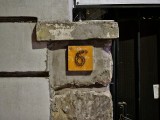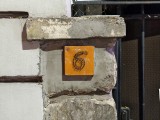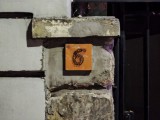200MP vs 1-inch - testing the best Android phones for photography

The main cameras in low light
We tested the main and zoom cameras in low light. We left out the ultrawides in the low-light testing to keep this comparison from getting bloated and endless and also because none of the ultrawides takes particularly good photos at night.
At 23mm, the main cameras are already wide enough to capture most night scenes adequately and have a huge sensor advantage over the ultrawide cameras.
All four phones have an Auto Night mode and a dedicated night mode. The auto mode kicks in and boosts the detail and exposure of the image. If you manually enable Night mode, you'll get an even better result, generally speaking.
For our testing, we didn't use Auto Night mode - we shot the first images with Night mode off (Auto Night mode off, too), and the second set with Night mode turned on.
With Night mode off, the Galaxy S23 Ultra has the darkest overall exposures. It's once again the sharpest and the second most detailed, but it's the noisiest shooter with some muddy patches here and there. It had issues with light sources, especially point light, where it would blow some of the highlight data.
The vivo X90 Pro snaps the brightest images with the most detail and the nicest sharpening - not too much, not too little - just right. The Vivo outputs the most saturated colors, and its white balance is the warmest, which in combination with the greater detail and brighter exposure, leads to the most stunning low-light photos here. Bravo!
The Xiaomi 13 Pro has the narrowest dynamic range here. It often overexposes the highlights and crushes the darkest of the shadows. Otherwise, it brings in a great amount of detail and sharpening is just right. The white balance is spot on, but the colors are a bit dull.
The Xiaomi 12S Ultra also blows out its highlights but manages to retain more of the shadow detail. Textures have a slightly artificial look because of excessive sharpening.








Night mode off: Galaxy S23 Ultra • Vivo X90 Pro • Xiaomi 13 Pro • Xiaomi 12S Ultra








Night mode off: Galaxy S23 Ultra • Vivo X90 Pro • Xiaomi 13 Pro • Xiaomi 12S Ultra
When Night mode is engaged, the Galaxy S23 Ultra offers mixed results. The first two images - the lion statue and the hotel building - lose much of the fine detail to noise reduction. Typically this tradeoff is worth it but not in this case. We'd pick the reasonably noisy photo with great detail over the artificial mess of a Night mode any day. To its credit, Night mode manages to recover the blown-out highlight data. The other two scenes - the outdoor restaurant and the indoor bar - are examples of a Night mode done right - exposures are brighter, more detailed in the shadows and less noisy.
The Vivo X90 Pro leaves the details, colors, and the already boosted shadows untouched and goes about saving blown highlights. It generally succeeds - the only example where it fails is the first scene (the lion), where the regular shot has more highlight data than the night mode image. This is likely a fluke, rather than the norm, and the Vivo X90 Pro remains the best low-light camera here.
The Xiaomi 13 Pro's dedicated Night mode images get a very slight boost in the shadows and lose some of their fine detail in exchange for lower noise. The blow-out highlights are brought back. Overall a win-win.
The Xiaomi 12S Ultra gets a great benefit from Night mode. Highlights are brought back in check, shadows get a slight boost, and there's still no noise to speak of. Great results.








Night mode on: Galaxy S23 Ultra • Vivo X90 Pro • Xiaomi 13 Pro • Xiaomi 12S Ultra
When using the main cameras, the Vivo X90 Pro is the best in low light. It snaps standout images - bright, vivid images with loads of detail and expert sharpening. The Xiaomi 12S Ultra is the closest to the X90 Pro. The Galaxy S23 Ultra and 13 Pro are on par - the Galaxy is sharper and more detailed but has an overall darker look than the Xiaomi 13 Pro.








Night mode on: Galaxy S23 Ultra • Vivo X90 Pro • Xiaomi 13 Pro • Xiaomi 12S Ultra
Zoom cameras in low light
The Vivo X90 Pro has the best zoom camera in low light. Its images are bright with excellent shadow and highlight detail. The pleasant colors carry over from the main-camera images. The Galaxy S23 Ultra and Xiaomi 13 Pro are very close in terms of detail. With Night mode off, the Xiaomi 13 Pro captures more detail than the Galaxy, but it blows out the highlights. The Galaxy, on the other hand, is noisier. We'd call it a tie for second place.
The Xiaomi 12S Ultra's 120mm camera is the worst in low light. It struggles to capture detail, and most of what it does capture gets lost to the aggressive noise reduction algorithm.








Night mode off: Samsung Galaxy S23 Ultra 69mm • Vivo X90 Pro 50mm • Xiaomi 13 Pro 75mm • Xiaomi 12S Ultra 120mm
Turning on night mode does some good for the Galaxy S23 Ultra zoom images. Detail increases, and the noise, which was the worst here, is reduced. The Xiaomi 13 Pro loses the detail edge, and while it brings back the highlight information, those highlights become unnaturally dark and yellow.
The Xiaomi 12S Ultra's images become tolerable. There's more detail and better highlights. But it's still the weakest zoom here.
Little changes in the Vivo X90 Pro's images with Night mode. Highlights are better preserved, but slightly. Still, these remain the nicest zoom photos in low light.








Night mode on: Samsung Galaxy S23 Ultra 69mm • Vivo X90 Pro 50mm • Xiaomi 13 Pro 75mm • Xiaomi 12S Ultra 120mm
The Vivo X90 Pro may not have the zoomiest of zoom cameras, but it's the only one we'd shoot portrait photos with in low light. The Xiaomi 12S Ultra's zoom camera lacks a Night Portrait mode, and it's a blotchy, colorless mess in low light. The Xiaomi 13 Pro and Galaxy S23 Ultra's zoom cameras have Night Portrait mode but the results aren't great. The subject is noisy and underexposed in both images.
The Vivo X90 Pro's Night Portrait mode brightens up the subject and processes the background nicely. It's a bit overdone, but it's usable, which we can't really say about the rest.




Samsung Galaxy S23 Ultra 69mm • Vivo X90 Pro 50mm • Xiaomi 13 Pro 75mm • Xiaomi 12S Ultra 120mm
So overall, repeating the result from the main camera comparison, Vivo X90 Pro turned out to have the best zoom camera, quality-wise. In good light, it captured vivid images with an excellent level of detail and good dynamic range. But the 50mm f/1.6 camera is still just as impressive in low light, whereas the rest lose most of their quality. The Xiaomi 13 Pro's 75mm camera is a distant second, slightly in front of the Galaxy S23 Ultra's 69mm shooter. The 13 Pro's zoom just has a better sensor and a brighter lens that help it achieve a finer photo than the Galaxy, most of the time. But we expected much more from Xiaomi's touted portrait camera.
The Xiaomi 12S Ultra's 120mm excels in bringing scenes closer to you. But if you disregard its zoom advantage for a moment, it doesn't stand up to the smaller zooms in terms of quality.
Reader comments
- Gowtham
- 05 Jun 2024
- 7k}
Im using Vivo for the past 5 years as always buying in Vivo Mobile online . Always giving my rating 4.5/5
- Underbreg
- 27 May 2024
- 3Z5
Please note that 1 inch sensor has diagonal of only 0.65" due to a marketing trick. 1" refers to a tube width and sensor inside is smaller. Thus 1/1.3" sensor has diagonal around 0.5".
- Anonymous
- 20 May 2024
- n5n
glass is made from sand, gorilla glass is just reinforced in the manufacturing process so it’s much more resilient than normal glass.